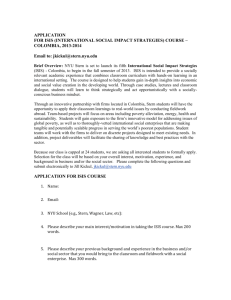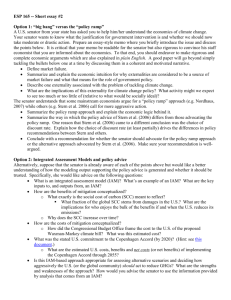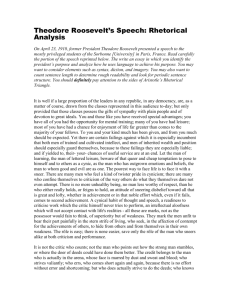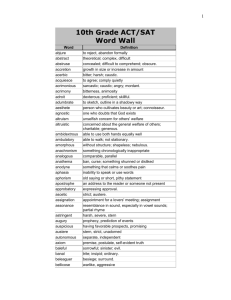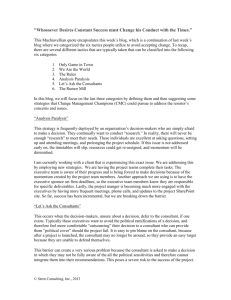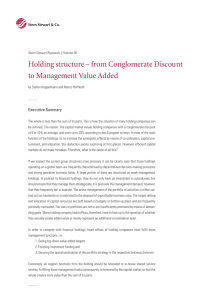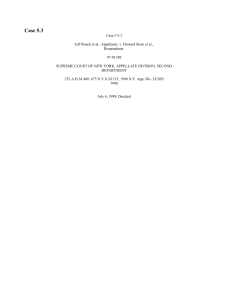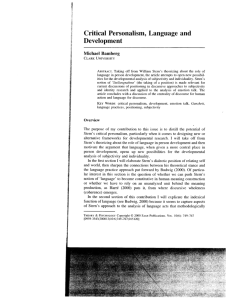Plant Production - Jordan University of Science and Technology
advertisement
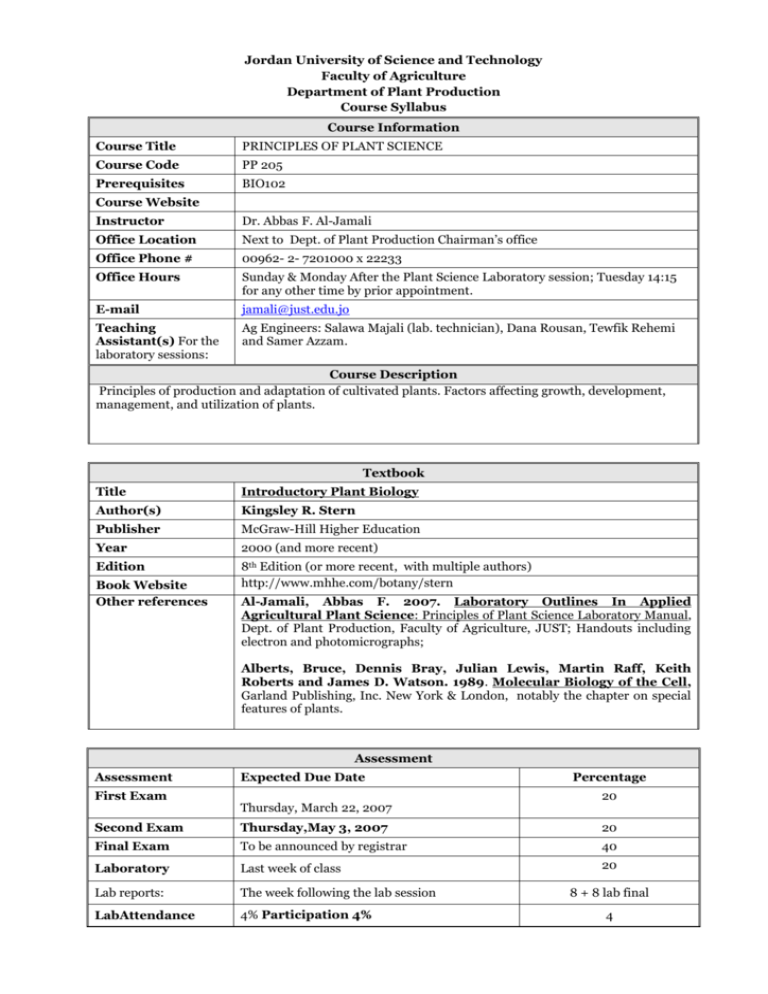
Jordan University of Science and Technology Faculty of Agriculture Department of Plant Production Course Syllabus Course Information Course Title PRINCIPLES OF PLANT SCIENCE Course Code PP 205 Prerequisites BIO102 Course Website Instructor Dr. Abbas F. Al-Jamali Office Location Next to Dept. of Plant Production Chairman’s office Office Phone # 00962- 2- 7201000 x 22233 Office Hours Sunday & Monday After the Plant Science Laboratory session; Tuesday 14:15 for any other time by prior appointment. E-mail jamali@just.edu.jo Teaching Assistant(s) For the laboratory sessions: Ag Engineers: Salawa Majali (lab. technician), Dana Rousan, Tewfik Rehemi and Samer Azzam. Course Description Principles of production and adaptation of cultivated plants. Factors affecting growth, development, management, and utilization of plants. Textbook Title Introductory Plant Biology Author(s) Kingsley R. Stern Publisher McGraw-Hill Higher Education Year 2000 (and more recent) Edition 8th Edition (or more recent, with multiple authors) http://www.mhhe.com/botany/stern Book Website Other references Al-Jamali, Abbas F. 2007. Laboratory Outlines In Applied Agricultural Plant Science: Principles of Plant Science Laboratory Manual, Dept. of Plant Production, Faculty of Agriculture, JUST; Handouts including electron and photomicrographs; Alberts, Bruce, Dennis Bray, Julian Lewis, Martin Raff, Keith Roberts and James D. Watson. 1989. Molecular Biology of the Cell, Garland Publishing, Inc. New York & London, notably the chapter on special features of plants. Assessment Assessment First Exam Expected Due Date Thursday, March 22, 2007 Percentage 20 Second Exam Thursday,May 3, 2007 20 Final Exam To be announced by registrar 40 Laboratory Last week of class 20 Lab reports: The week following the lab session LabAttendance 4% Participation 4% 8 + 8 lab final 4 Course Objectives 1. Percentage Realizing the importance of plants in our life. Learning the structure & ultra structure of plant cells in relation to crop production, both in theory and hands on via the lab sessions and field trip. 25% 2. Learning classification of plants and the relation of structure to function via studying the anatomy and morphology of gymnosperms (Jordanian forest species notably Aleppo pine) and Angiosperms (Monocots and Dicots) especially characters making plants adapted to the Jordanian environment (arid and semi arid). 25% 3. Getting to know crops and their production techniques in fields, orchards, glass houses, plastic houses and nurseries including, protection, irrigation and fertilization. 30% 4. Plant Ecology: Definitions, Energy pyramid, Importance of Balance & plant nutrient cycles (e.g. N & C) in nature 10% 5. 10% Getting to know the applications of types of plant reproduction both sexual & asexual, tissue culture & biotechnology. Teaching & Learning Methods For this course the learning is derived from a combination of the texts, lectures and the laboratory work by the students themselves. Laboratory sessions are preceded by an illustrated explanation of what is to be done and learned. Any good work or results by a student e.g. a good double stained microscopic freehand section showing the casparian strip in a dicot root endodermis will not only be shown to all the other students but will be recompensed with a bonus grade. Innovation and initiative are also rewarded. For techniques of teaching, all methods that keep the teacher and student interested and clarify the point are good, from story telling to play acting via slide shows, video, overhead transparencies, chalk and talk to mobile phone cameras & the internet. For more details of aims refer to the preface of the lab manual above (Al-Jamali, 2007). Useful Resources 1. Arabic and foreign books, journals, & encyclopedias via University Library; 2. CDs or the Internet via search engines are a source of information of mixed quality. In case information conflicts with what is given in the lectures or text, ask the professor! (In class, office hours or by appointment). 3. Videos by the ministry of agriculture extension services as well as scientific programs aired on local and international TV stations can be very useful. The textbook and its website have links to many video clips and scientific experiments of interest. Course Content Week Topics Chapter in Textbook (handouts) 3 THE IMPORTANCE OF PLANTS, PLANT NAMES AND CLASSIFICATION THE NATURE OF LIFE 4 THE PLANT CELL: PLASTIDS Stern (2000) Ch3; Alberts et al. (1989)& Al-Jamali (2007) 5&6 VACUOLES AND CELL WALLS Stern (2000) Ch3; Alberts et al. (1989)& Al-Jamali (2007) 7 PLANT TISSUES Stern (2000) Ch4 Alberts et al. (1989)& Al-Jamali (2007) 8 ROOTS Stern (2000) Ch5 Al-Jamali (2007) 9 STEMS Stern (2000) Ch6 Al-Jamali (2007) 10 LEAVES Stern (2000) Ch7 Al-Jamali 1&2 Stern (2000) Ch 1 & Ch16 Stern (2000) Ch.2 (2007) 11&12 13 14 15 16 Flowers and Inflorescences, Fruits and Seeds Stern (2000) Ch8 Al-Jamali (2007) Plant metabolism Stern (2000) Ch10, Ch11 & Ch12 Plant growth and development Stern (2000) Ch10, Ch11 & Ch12 Plant propagation; plant genetics and biotechnology Stern (2000) Ch14 Plant ecology & revision Stern (2000) Ch25 Plant Science Laboratory Week 1 Subject Introduction and slide show 2,3,4&5 Cytology & ANATOMY 1. Plastids 2. Vacuoles 3. Cell Walls 4. Tissues 7 Roots Function, Anatomy, Morphology- Types & Modifications. 8 Stems Function, Anatomy, Morphology- Types & Modifications. 9 Leaves Function, Anatomy, Morphology- Types & Modifications. 10 Flowers and Inflorescences 11 Fruits and Seeds 12 Propagation Sexual and Asexual- Greenhouse and Tissue Culture Lab 13 Plant Production Green House, Field and Orchard 14 Revision and Final N.B. : The sequence and content of the lectures and laboratory sessions may be modified for weather and other circumstances. There will be a required study trip to the Jordan Valley, on a Saturday, to become acquainted with the crops and methods of plant production.

